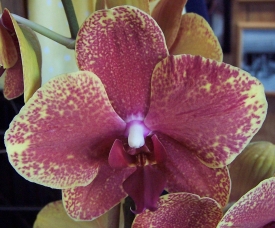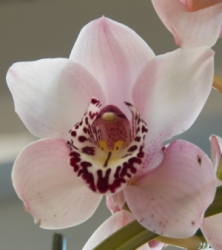The Orchid Care Guide
A Word About Orchids

Orchids have a bad reputation for being difficult to grow. However, if you follow a few guidelines, orchids can be easy to grow and enjoy. The information provided below is a general guideline for taking care of most orchids.
Temperature and Humidity
There are three basic temperature categories: cool, warm, and intermediate. Most orchids will fall into one or two of these categories. Basically, most orchids like to be in a 70° - 80° F climate during the day with a 10° to 15° degree drop in temperature during the night. Cool growing orchids thrive where nighttime temperatures are in the mid 50° range. Intermediate growing orchids like it slightly warmer in the night. Orchids do best when not subjected to extreme temperature changes.
All orchids require some humidity to grow well. If you need to increase the humidity level around your orchids, they can be placed in a tray filled with water and gravel or small stones. Make sure the water level does not touch the bottom of the orchid pots. Also, occasional misting with a spray bottle or simply placing several orchids close together can create sufficient humidity.
Light
Light is an important factor in growing orchids and inducing plants to bloom. Orchids generally grow best in well-lit areas, but avoid hot areas. An east-facing or north-facing window is usually a good location. Lack of adequate light is a main reason for an orchid’s failure to bloom. Also, too much light can cause damage to the orchid. Natural and artificial light can be used to provide proper lighting. Some experimentation and observation will be needed to find the best location for your orchids.
Water

Generally, most orchids will require about once a week watering. Container size, growing medium, heat, and lighting will determine if more frequent or less frequent watering is necessary. It is best to use water at room temperature, and to apply evenly over the surface, not in just one spot. Never leave an orchid pot standing in water. Avoid watering orchids with water from water softeners that add sodium to the water.
Fertilizer
All orchids require fertilizer to grow and bloom well. Generally, after an orchid has finished blooming, a growth formula (30-10-10) should be used for 3 to 4 months. After using the growth formula, switch to the Orchid Bloom formula (6-30-30). Use the bloom formula until flower spikes appear. Once your orchid begins bloom, stop fertilizing. No fertilizer is needed while your plant is blooming. Once your plant stops blooming, begin the fertilizing process again. Fertilizers should be applied about every 2 – 4 weeks or as the specific fertilizer recommends. Always remember to water your orchids first before applying a fertilizer.
Repotting Orchids
Most orchids should be repotted
every couple of years with orchid bark or an orchid mix. Repotting may consist
of just replacing the existing growing medium without moving the orchid to a
larger pot. If, for no apparent reason, your orchid is not doing well, try
repotting. When moving your orchid to a larger pot, be conservative. A bigger
pot is not always better.